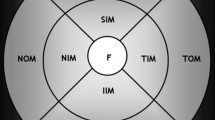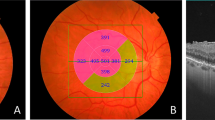Abstract
Background
Using standardized macular optical coherence tomography (OCT) in the postoperative period, subclinical changes in macular thickness can be detected. With this method, postoperative development of macular thickness in healthy eyes is evaluated. The repeatability of the method and the influence of selected surgical (phaco time and phaco energy) and biometric parameters (axial length and anterior chamber depth) on the results were assessed.
Methods
In a prospective study, 33 patients without macular pathology in both eyes were examined. Phacoemulsification and intraocular lens (IOL) implantation was performed in one eye, and the contralateral eye served as control. OCT (StratusOCT; Zeiss, Dublin, CA, USA), mean minimal foveal thickness (MMFT) and mean foveal thickness (MFT) were measured preoperatively, at 1 day, 1 week and 6 weeks postoperatively.
At these visits, the best-corrected visual acuity (BCVA) tests and slit-lamp examination were performed. To assess the influence on foveal thickness ocular axial length, anterior chamber depth, phacotime and energy were documented. Statistical analysis using parametric tests was carried out with standard statistical software (SPSS11, BIAS).
Results
MMFT of the operated eyes and the intraindividual difference of MMFT increased significantly at one day (+12.31 ± 24.2 μm, P < 0.001) and 6 weeks (+6.76 ± 22.6 μm, P = 0.009). MFT in the operated eyes and intraindividual difference of MFT rose significantly at 1 day, 1 week and 6 weeks (1 day: +10.66 ± 20.8 μm, P = 0,026; 1 week: +15.23 ± 19.7 μm; 6 weeks: +17.33 ± 14.81 μm, P < 0.001). Repeatability was better for MFT in controls (ICR = 0.92) than for MMFT in controls (ICR = 0.77). No clinical cystoid macular edema was diagnosed in this study. No correlation between macular thickening and visual acuity and selected surgical and biometrical parameters could be found.
Conclusions
After cataract surgery, a mild increase of foveal thickness without impact on visual acuity could be observed. This increase may be due to both subclinical changes and to influence of changes in media opacity on the measurement technique. Surgical and biometric parameters such as phacotime and energy and axial length did not correlate to the degree of macular thickening.




Similar content being viewed by others
References
Mentes J, Erakgun T, Afrashi F, Kerci G (2003) Incidence of cystoid macular edema after uncomplicated phacoemulsification. Ophthalmologica 217(6):408–412
Francois J, Verbraeken H (1980) Complications in 1,000 consecutive intracapsular cataract extractions. Ophthalmologica 180(3):121–128
Norregaard JC, Bernth-Petersen P, Bellan L et al (1999) Intraoperative clinical practice and risk of early complications after cataract extraction in the United States, Canada, Denmark, and Spain. Ophthalmology 106(1):42–48
Ursell PG, Spalton DJ, Whitcup SM, Nussenblatt RB (1999) Cystoid macular edema after phacoemulsification: relationship to blood-aqueous barrier damage and visual acuity. J Cataract Refract Surg 25(11):1492–1497
Browning DJ, McOwen MD, Bowen RM Jr, O’Marah TL (2004) Comparison of the clinical diagnosis of diabetic macular edema with diagnosis by optical coherence tomography. Ophthalmology 111(4):712–715
Brown JC, Solomon SD, Bressler SB et al (2004) Detection of diabetic foveal edema: contact lens biomicroscopy compared with optical coherence tomography. Arch Ophthalmol 122(3):330–335
Schaudig U, Scholz F, Lerche RC, Richard G (2004) Optical coherence tomography for macular edema. Classification, quantitative assessment, and rational usage in the clinical practice. Ophthalmologe 101(8):785–793
Sourdille P, Santiago PY (1999) Optical coherence tomography of macular thickness after cataract surgery. J Cataract Refract Surg 25(2):256–261
Lobo CL, Faria PM, Soares MA et al (2004) Macular alterations after small-incision cataract surgery. J Cataract Refract Surg 30(4):752–760
Ching HY, Wong AC, Wong CC et al (2006) Cystoid macular oedema and changes in retinal thickness after phacoemulsification with optical coherence tomography. Eye 20(3):297–303
Gobel W, Hartmann F, Haigis W (2001) Determination of retinal thickness in relation to the age and axial length using optical coherence tomography. Ophthalmologe 98(2):157–162
Grewing R, Becker H (2000) Retinal thickness immediately after cataract surgery measured by optical coherence tomography. Ophthalmic Surg Lasers 31(3):215–217
Hee MR (2005) Artifacts in optical coherence tomography topographic maps. Am J Ophthalmol 139(1):154–155
Biro Z, Balla Z, Kovacs B (2006) Change of foveal and perifoveal thickness measured by OCT after phacoemulsification and IOL implantation. Eye [Epub ahead of print]
Hee MR, Puliafito CA, Wong C et al (1995) Quantitative assessment of macular edema with optical coherence tomography. Arch Ophthalmol 113(8):1019–1029
Sadda SR, Wu Z, Walsh AC et al (2006) Errors in retinal thickness measurements obtained by optical coherence tomography. Ophthalmology 113(2):285–293
Ray R, Stinnett SS, Jaffe GJ (2005) Evaluation of image artifact produced by optical coherence tomography of retinal pathology. Am J Ophthalmol 139(1):18–29
Ball JL, Barrett GD (2006) Prospective randomized controlled trial of the effect of intracameral vancomycin and gentamicin on macular retinal thickness and visual function following cataract surgery. J Cataract Refract Surg 32(5):789–794
van Velthoven ME, van der Linden MH, de Smet MD et al (2006) Influence of cataract on optical coherence tomography image quality and retinal thickness. Br J Ophthalmol 90:1159–1162
Chan A, Duker JS (2005) A standardized method for reporting changes in macular thickening using optical coherence tomography. Arch Ophthalmol 123(7):939–943
Chan A, Duker JS, Ko TH et al (2006) Normal macular thickness measurements in healthy eyes using Stratus optical coherence tomography. Arch Ophthalmol 124(2):193–198
Paunescu LA, Schuman JS, Price LL et al (2004) Reproducibility of nerve fiber thickness, macular thickness, and optic nerve head measurements using StratusOCT. Invest Ophthalmol Vis Sci 45(6):1716–1724
Sacu S, Findl O, Linnola RJ (2005) Optical coherence tomography assessment of capsule closure after cataract surgery. J Cataract Refract Surg 31(2):330–336
Luo HD, Gazzard G, Fong A et al (2006) Myopia, axial length, and OCT characteristics of the macula in Singaporean children. Invest Ophthalmol Vis Sci 47(7):2773–2781
Chamberlain MD, Guymer RH, Dirani M et al (2006) Heritability of macular thickness determined by optical coherence tomography. Invest Ophthalmol Vis Sci 47(1):336–340
Hougaard JL, Wang M, Sander B, Larsen M (2001) Effects of pseudophakic lens capsule opacification on optical coherence tomography of the macula. Curr Eye Res 23(6):415–421
Larsen M, Wang M, Sander B (2005) Overnight thickness variation in diabetic macular edema. Invest Ophthalmol Vis Sci 46(7):2313–2316
Lim MC, Hoh ST, Foster PJ et al (2005) Use of optical coherence tomography to assess variations in macular retinal thickness in myopia. Invest Ophthalmol Vis Sci 46(3):974–978
Paques M, Massin P, Sahel JA et al (2005) Circadian fluctuations of macular edema in patients with morning vision blurring: correlation with arterial pressure and effect of light deprivation. Invest Ophthalmol Vis Sci 46(12):4707–4711
Polito A, Del Borrello M, Polini G et al (2006) Diurnal variation in clinically significant diabetic macular edema measured by the Stratus OCT. Retina 26(1):14–20
Savini G, Zanini M, Barboni P (2006) Influence of pupil size and cataract on retinal nerve fiber layer thickness measurements by stratus OCT. J Glaucoma 15(4):336–340
Sadda SR, Tan O, Walsh AC et al (2006) Automated detection of clinically significant macular edema by grid scanning optical coherence tomography. Ophthalmology 113(7):1196 e1–2
Ohrloff C, Schalnus R, Rothe R, Spitznas M (1990) Role of the posterior capsule in the aqueous-vitreous barrier in aphakic and pseudophakic eyes. J Cataract Refract Surg 16(2):198–201
Author information
Authors and Affiliations
Corresponding author
Additional information
The authors have no financial or proprietary interest in any material or method mentioned.
Rights and permissions
About this article
Cite this article
von Jagow, B., Ohrloff, C. & Kohnen, T. Macular thickness after uneventful cataract surgery determined by optical coherence tomography. Graefes Arch Clin Exp Ophthalmol 245, 1765–1771 (2007). https://doi.org/10.1007/s00417-007-0605-6
Received:
Revised:
Accepted:
Published:
Issue Date:
DOI: https://doi.org/10.1007/s00417-007-0605-6




